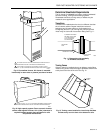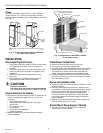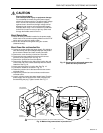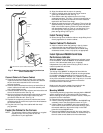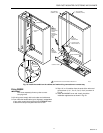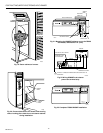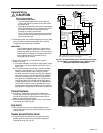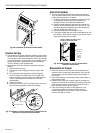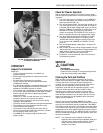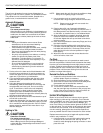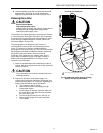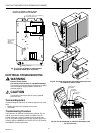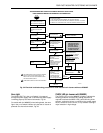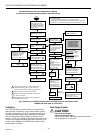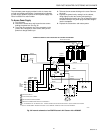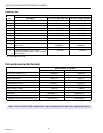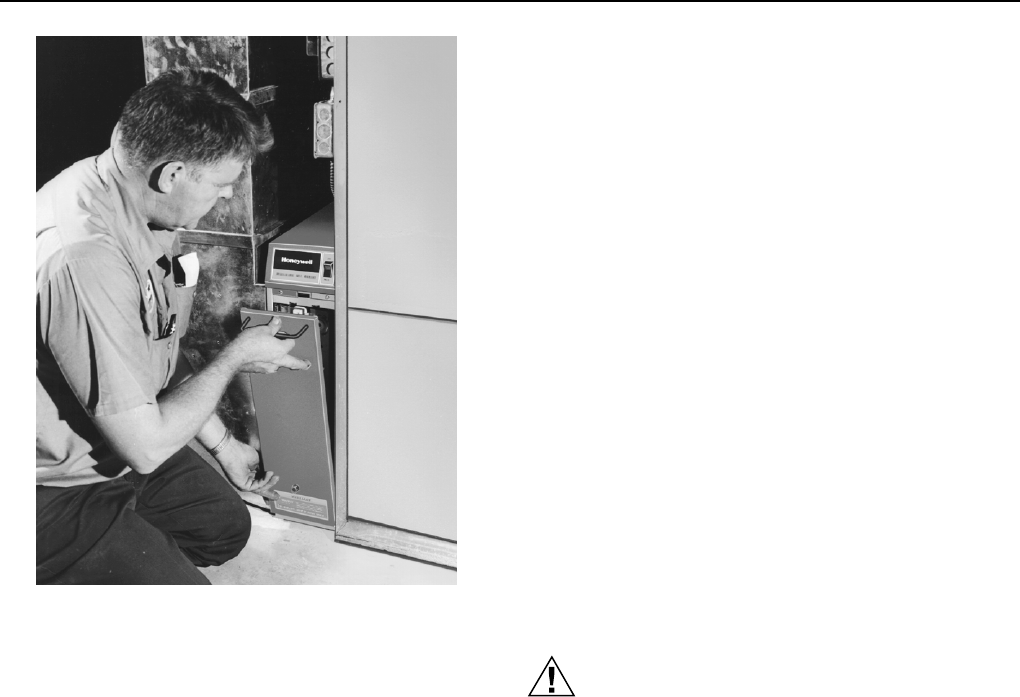
F50E DUCT MOUNTED ELECTRONIC AIR CLEANER
68-0072—5
15
Fig. 29. Close access door to complete
air cleaner installation.
CHECKOUT
Inspect the Installation
Make sure:
• Turning vanes and transitions, as needed, are
properly installed.
• Sheet metal joints between air cleaner and furnace
are sealed.
• All sheet metal connections are complete.
• Original furnace filter was removed and the blower
compartment cleaned.
• If an atomizing humidifier is installed upstream of the air
cleaner, that a disposable furnace filter is installed
between the humidifier and the air cleaner.
• If the furnace has a multispeed or modulating blower (and
an air cleaner without solid state air flow switch is used),
that an interlock (sail switch or dpdt relay) provides
electrical isolation.
• Outside air, if used, is mixed with return air or heated as
necessary before it can reach the air cleaner.
• The high voltage contacts on the cell touch the spring
contacts in the contact tray.
• The airflow arrows on the electronic cells point downstream.
• The prefilters are on the upstream side of the cells.
• The cell handles face outward.
• The electronic cells and prefilters are clean and dry.
• The wiring connections inside the junction box or power
box are properly made. See Fig. 24.
• That W8600E (if included) wiring connections are
properly made.
Check Air Cleaner Operation
With all components in place, turn on the air cleaner switch
and energize the system blower. Check the following points of
operation:
1. The neon light in the on-off switch is on. If a W8600E is
part of the installation, also check the wall panel and
make sure the ON LED is lit.
2. Turn off the system blower. The neon light should go off.
The neon light comes on to show that the air cleaner is
energized and the high voltage power supply is working
properly. If W8600E is used with air cleaner that has air
flow switch, the neon light shows only that the air
cleaner is energized. The CHECK LED will come on if
there is a problem with the high voltage power supply.
3. Turn the system blower back on. With the air cleaner
energized, push the test button. A snapping sound
indicates that collector voltage is present on the cells.
On air cleaner with a W8600E, the CHECK LED will
come on.
4. With a multispeed blower, repeat steps 1 through 3 for
each fan speed.
5. With a meter, check the ionizer voltage between P3 (red
lead) and ground, and the collector voltage between P4
(black lead) and ground. The correct voltages are
printed on the label inside the access door.
6. If operation is not as described, refer to the Electrical
Troubleshooting section.
SERVICE
CAUTION
Sharp Edges.
Can cause personal injury.
Handle the cells carefully or wear protective gloves to
avoid cuts from the sharp metal edges.
Cleaning the Cells and Prefilters
When enough lint accumulates to block the air flow, the
prefilter can quickly become clogged. Inspect the prefilters
monthly, and clean if necessary to prevent possible lint
clogging. The cell washing can also be done at this time, or
can wait until next inspection if cells still look clean.
Regardless, clean the cells and prefilters regularly—every
one to six months. Variables such as number of family
members, pets, activities and whether anyone smokes
indoors determine how often cleaning is required. Use the
wash reminder schedule on top of the air cleaner to record
dates of cell washings, to help establish and to maintain a
regular cleaning schedule.
If the air cleaner has the optional W8600E Solid State
Performance Indicator, the WASH LED will come on to remind
you that a cell and prefilter washing is past due. If the WASH
LED seems to light soon after a cell washing, thorough wiping
of the ionizer wires may be all that is needed. Cells should be
washed and ionizer wires wiped frequently enough to prevent
WASH LED from coming on. The WASH LED will not come on
when the prefilters get clogged; clean the prefilters every time
the cells are cleaned.
NOTE: If an ultrasonic room humidifier is used often,
especially when filled with tap (undistilled) water, the
cells will require more frequent washing. A white
residue will accumulate on the cells from the
minerals in the water.



